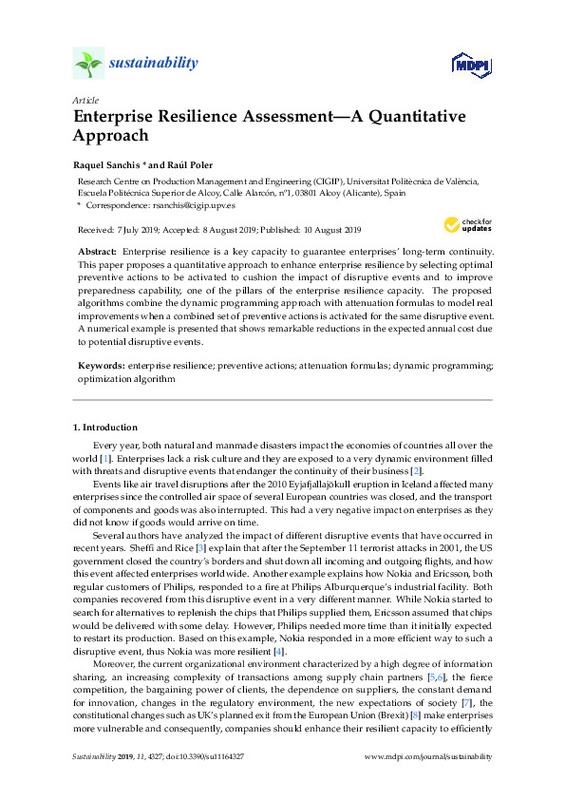Baghersad, M., & Zobel, C. W. (2015). Economic impact of production bottlenecks caused by disasters impacting interdependent industry sectors. International Journal of Production Economics, 168, 71-80. doi:10.1016/j.ijpe.2015.06.011
Cagliano, A. C., De Marco, A., Grimaldi, S., & Rafele, C. (2012). An integrated approach to supply chain risk analysis. Journal of Risk Research, 15(7), 817-840. doi:10.1080/13669877.2012.666757
Vanpoucke, E., Boyer, K. K., & Vereecke, A. (2009). Supply chain information flow strategies: an empirical taxonomy. International Journal of Operations & Production Management, 29(12), 1213-1241. doi:10.1108/01443570911005974
[+]
Baghersad, M., & Zobel, C. W. (2015). Economic impact of production bottlenecks caused by disasters impacting interdependent industry sectors. International Journal of Production Economics, 168, 71-80. doi:10.1016/j.ijpe.2015.06.011
Cagliano, A. C., De Marco, A., Grimaldi, S., & Rafele, C. (2012). An integrated approach to supply chain risk analysis. Journal of Risk Research, 15(7), 817-840. doi:10.1080/13669877.2012.666757
Vanpoucke, E., Boyer, K. K., & Vereecke, A. (2009). Supply chain information flow strategies: an empirical taxonomy. International Journal of Operations & Production Management, 29(12), 1213-1241. doi:10.1108/01443570911005974
Chaudhuri, A., Boer, H., & Taran, Y. (2018). Supply chain integration, risk management and manufacturing flexibility. International Journal of Operations & Production Management, 38(3), 690-712. doi:10.1108/ijopm-08-2015-0508
Oliva, F. L. (2016). A maturity model for enterprise risk management. International Journal of Production Economics, 173, 66-79. doi:10.1016/j.ijpe.2015.12.007
Hendry, L. C., Stevenson, M., MacBryde, J., Ball, P., Sayed, M., & Liu, L. (2019). Local food supply chain resilience to constitutional change: the Brexit effect. International Journal of Operations & Production Management, 39(3), 429-453. doi:10.1108/ijopm-03-2018-0184
Prior, T., & Hagmann, J. (2013). Measuring resilience: methodological and political challenges of a trend security concept. Journal of Risk Research, 17(3), 281-298. doi:10.1080/13669877.2013.808686
Holling, C. S. (1973). Resilience and Stability of Ecological Systems. Annual Review of Ecology and Systematics, 4(1), 1-23. doi:10.1146/annurev.es.04.110173.000245
Haimes, Y. Y. (2009). On the Definition of Resilience in Systems. Risk Analysis, 29(4), 498-501. doi:10.1111/j.1539-6924.2009.01216.x
Doorn, N. (2015). Resilience indicators: opportunities for including distributive justice concerns in disaster management. Journal of Risk Research, 20(6), 711-731. doi:10.1080/13669877.2015.1100662
Scholz, R. W., Blumer, Y. B., & Brand, F. S. (2012). Risk, vulnerability, robustness, and resilience from a decision-theoretic perspective. Journal of Risk Research, 15(3), 313-330. doi:10.1080/13669877.2011.634522
Reyes Levalle, R., & Nof, S. Y. (2015). Resilience by teaming in supply network formation and re-configuration. International Journal of Production Economics, 160, 80-93. doi:10.1016/j.ijpe.2014.09.036
Kamalahmadi, M., & Parast, M. M. (2016). A review of the literature on the principles of enterprise and supply chain resilience: Major findings and directions for future research. International Journal of Production Economics, 171, 116-133. doi:10.1016/j.ijpe.2015.10.023
Ponomarov, S. Y., & Holcomb, M. C. (2009). Understanding the concept of supply chain resilience. The International Journal of Logistics Management, 20(1), 124-143. doi:10.1108/09574090910954873
Comfort, L. K., Sungu, Y., Johnson, D., & Dunn, M. (2001). Complex Systems in Crisis: Anticipation and Resilience in Dynamic Environments. Journal of Contingencies and Crisis Management, 9(3), 144-158. doi:10.1111/1468-5973.00164
Ayyub, B. M. (2013). Systems Resilience for Multihazard Environments: Definition, Metrics, and Valuation for Decision Making. Risk Analysis, 34(2), 340-355. doi:10.1111/risa.12093
Cox Jr., L. A. T. (2012). Community Resilience and Decision Theory Challenges for Catastrophic Events. Risk Analysis, 32(11), 1919-1934. doi:10.1111/j.1539-6924.2012.01881.x
Schmitt, A. J., & Singh, M. (2012). A quantitative analysis of disruption risk in a multi-echelon supply chain. International Journal of Production Economics, 139(1), 22-32. doi:10.1016/j.ijpe.2012.01.004
Dabhilkar, M., Birkie, S. E., & Kaulio, M. (2016). Supply-side resilience as practice bundles: a critical incident study. International Journal of Operations & Production Management, 36(8), 948-970. doi:10.1108/ijopm-12-2014-0614
Dormady, N., Roa-Henriquez, A., & Rose, A. (2019). Economic resilience of the firm: A production theory approach. International Journal of Production Economics, 208, 446-460. doi:10.1016/j.ijpe.2018.07.017
Polyviou, M., Croxton, K. L., & Knemeyer, A. M. (2019). Resilience of medium-sized firms to supply chain disruptions: the role of internal social capital. International Journal of Operations & Production Management, 40(1), 68-91. doi:10.1108/ijopm-09-2017-0530
The Ripple Effect—How Manufacturing and Retail Executives View the Growing Challenge of Supply Chain Risk www2.deloitte.com/us/en/pages/operations/articles/supply-chain-risk-ripple-effect.html
Risk Ranking 2013–2015 http://www.ey.com/GL/en/Services/Advisory/Business-Pulse--top-10-risks-and-opportunities
Global Risk Management Survey—Executive Summary www.aon.com/2017-global-risk-management-survey/pdfs/2017-Aon-Global-Risk-Management-Survey-Full-Report-062617.pdf
The State of Enterprise Resilience Survey 2016/2017 www.controlrisks.com/our-thinking/insights/reports/the-state-of-enterprise-resilience-survey-2016-2017
20th CEO Survey www.pwc.com/gx/en/ceo-survey/2017/pwc-ceo-20th-survey-report-2017.pdf
BCI Supply Chain Resilience Report 2018 www.thebci.org/uploads/assets/uploaded/c50072bf-df5c-4c98-a5e1876aafb15bd0.pdf
The global risks report 2019 www.weforum.org/reports/the-global-risks-report-2019
Madni, A. M., & Jackson, S. (2009). Towards a Conceptual Framework for Resilience Engineering. IEEE Systems Journal, 3(2), 181-191. doi:10.1109/jsyst.2009.2017397
Pettit, T. J., Fiksel, J., & Croxton, K. L. (2010). ENSURING SUPPLY CHAIN RESILIENCE: DEVELOPMENT OF A CONCEPTUAL FRAMEWORK. Journal of Business Logistics, 31(1), 1-21. doi:10.1002/j.2158-1592.2010.tb00125.x
Bellman, R. (1954). The theory of dynamic programming. Bulletin of the American Mathematical Society, 60(6), 503-516. doi:10.1090/s0002-9904-1954-09848-8
Cord, J. (1964). A Method for Allocating Funds to Investment Projects when Returns are Subject to Uncertainty. Management Science, 10(2), 335-341. doi:10.1287/mnsc.10.2.335
Weingartner, H. M. (1966). Capital Budgeting of Interrelated Projects: Survey and Synthesis. Management Science, 12(7), 485-516. doi:10.1287/mnsc.12.7.485
Weingartner, H. M., & Ness, D. N. (1967). Methods for the Solution of the Multidimensional 0/1 Knapsack Problem. Operations Research, 15(1), 83-103. doi:10.1287/opre.15.1.83
Nemhauser, G. L., & Ullmann, Z. (1969). Discrete Dynamic Programming and Capital Allocation. Management Science, 15(9), 494-505. doi:10.1287/mnsc.15.9.494
Boyer, V., Baz, D. E., & Elkihel, M. (2010). Solution of multidimensional knapsack problems via cooperation of dynamic programming and branch and bound. European J. of Industrial Engineering, 4(4), 434. doi:10.1504/ejie.2010.035653
Skiena, S. S. (1999). Who is interested in algorithms and why? ACM SIGACT News, 30(3), 65-74. doi:10.1145/333623.333627
Chou, T.-C., & Talalay, P. (1983). Analysis of combined drug effects: a new look at a very old problem. Trends in Pharmacological Sciences, 4, 450-454. doi:10.1016/0165-6147(83)90490-x
Chou, T.-C., & Talalay, P. (1984). Quantitative analysis of dose-effect relationships: the combined effects of multiple drugs or enzyme inhibitors. Advances in Enzyme Regulation, 22, 27-55. doi:10.1016/0065-2571(84)90007-4
Belen’kii, M. S., & Schinazi, R. F. (1994). Multiple drug effect analysis with confidence interval. Antiviral Research, 25(1), 1-11. doi:10.1016/0166-3542(94)90089-2
Glossary of Terms and Symbols Used in Pharmacology. Pharmacology and Experimental Therapeutics Department at Boston University School of Medicine http://www.bumc.bu.edu/busm-pm/academics/resources/glossary/
Foucquier, J., & Guedj, M. (2015). Analysis of drug combinations: current methodological landscape. Pharmacology Research & Perspectives, 3(3), e00149. doi:10.1002/prp2.149
Tallarida, R. J. (2011). Quantitative Methods for Assessing Drug Synergism. Genes & Cancer, 2(11), 1003-1008. doi:10.1177/1947601912440575
[-]









